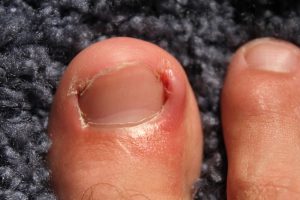Call our friendly podiatrists today on (08) 9586 3046

An ingrown toenail is a condition in which a spike, a serrated edge of the nail has pierced down the side of the nail fold. When this happens, it can lead to inflammation, swelling or accumulation of pus at the side/s of the nail. Hypergranulation (excessive tissue growth) tissues can also be seen on the nail folds in severe cases. The most common factors that lead to the ingrown toenail are faulty nail cutting, wearing poor-fitting footwear, tearing of the toenails, and excessive curvature of the toenails.
If the ingrown toenail is not infected, the splinter can be removed by your Podiatrists. Narrow-pointed footwear should be avoided to prevent direct excessive pressure. A suitable antiseptic solution such as Betadine can be used to treat and prevent any infection. If this is a recurrent problem, nail surgery will be necessary to permanently remove a small part of the nail. Occasionally we may recommend removing the entire toenail to achieve the best result.
What is ingrown toenail surgery?
Ingrown toenail surgery is a partial nail excision and chemical sterilization of the nail matrix performed under local anesthetic. It involves the removal of the ingrown portion of the toenail, together with the corresponding portion of the nail root, and the application of phenol to prevent that portion of the toenail from regrowing. This procedure is performed under local anesthetic and the prognosis is generally very good. The procedure takes approximately one hour.
If you are taking Aspirin or Warfarin, please check with your doctor or pharmacist on whether it’s safe for you to go off them for 1 week before your surgery. This help to minimize bleeding afterward.
Do you remove the entire toenail?
In most cases, we only need to remove one edge of the nail. Once the toe is healed the toenail simply looks slightly narrower but straighter.
In more severe cases, where the nail is severely deformed and causing pain on both edges of the toe, we may recommend removing the entire toenail to achieve the best result.
Can an ingrown toenail grow back after surgery?
There is a small chance an ingrown toenail can grow back after surgical treatment, but this only happens to about 5% of the cases. In other words, you have a 95% success rate.
Will I need time off work or school?
Immediately after the procedure you should rest and keep your foot elevated for the rest of the day. You will also need to wear an open-toe shoe for 1-2 weeks and avoid high heels and tight-fitting footwear.
Most people recover very quickly from ingrown toenail surgery and can return to work (for light duties) or school within a day or two. You should not participate in physical education, sports, or swimming for two weeks after the procedure.
If you have a physically demanding occupation, we suggest you take 3-7 days off.
Will I need to take antibiotics?
With any surgical procedure, there is a risk of developing an infection as the wound heals. It is important that you follow our instructions for cleaning and dressing your toe, and that you keep your toe clean and dry.
We will review your foot regularly after surgery to ensure your toe is healing well. If there are no signs of infection (increasing pain, pus, heat, redness, or swelling), it is unlikely you will need to take antibiotics.
What can I expect after my surgery?
Post-operative instructions in the first week:
Post-operative instructions after the first week: